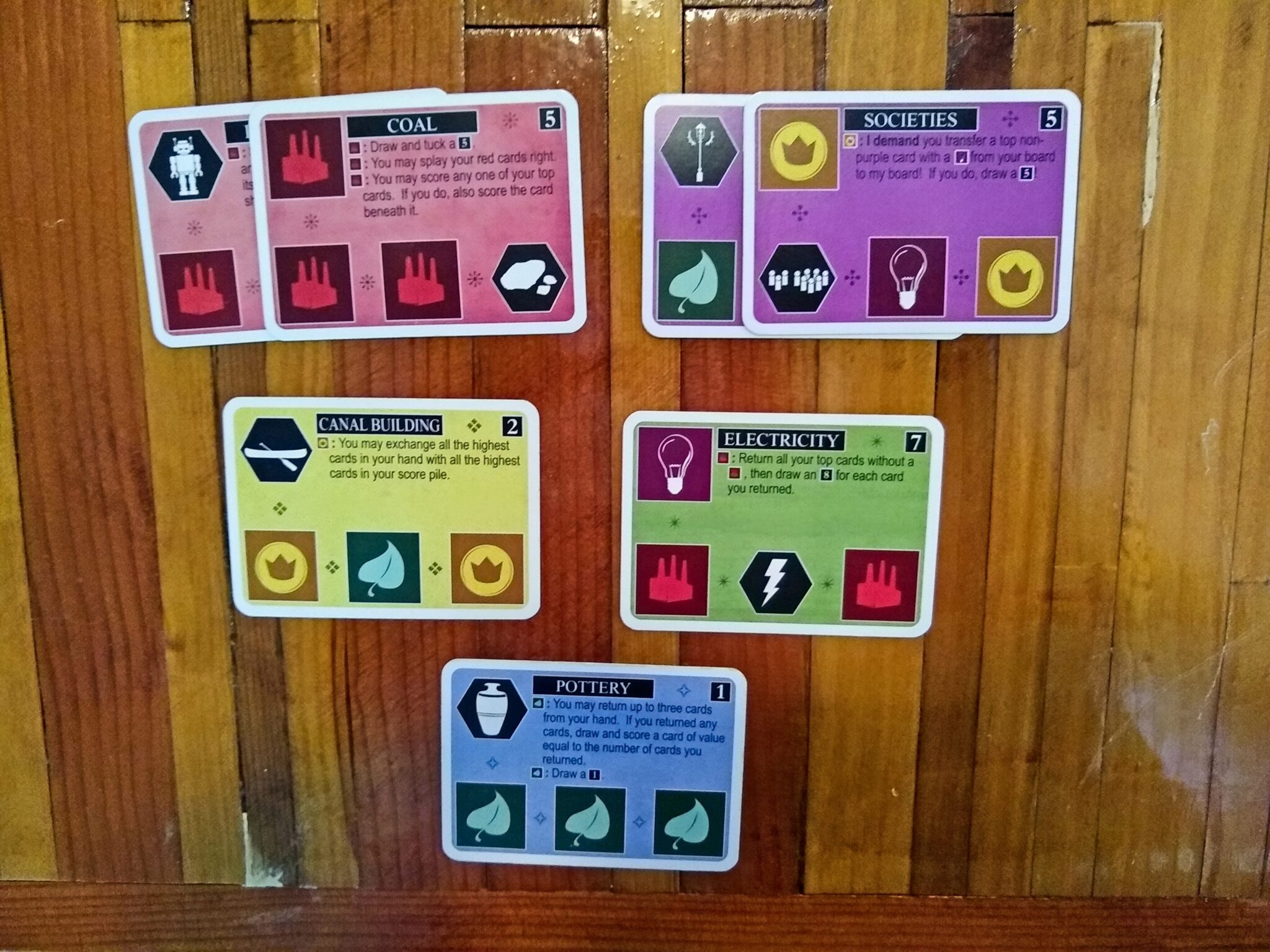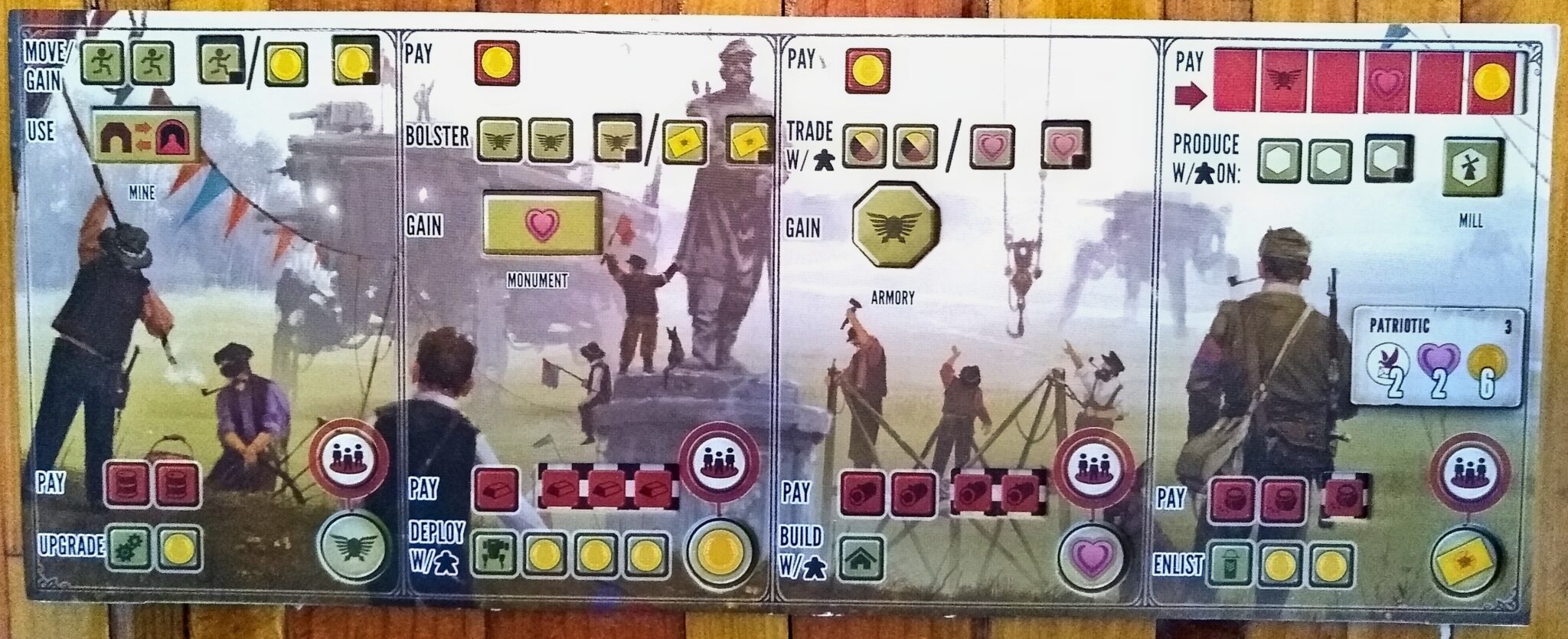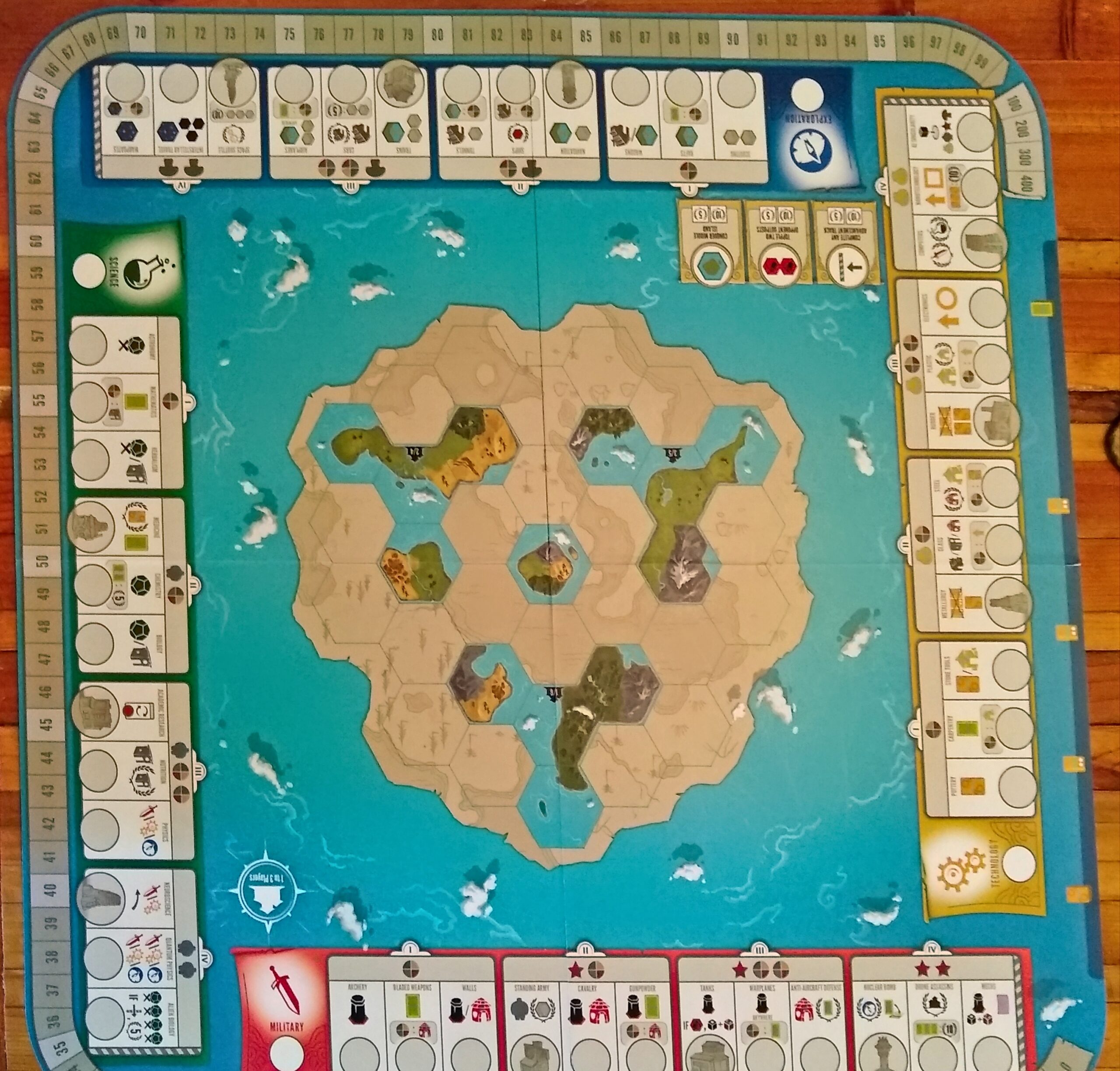My gut sense is that a tech track is a series of increasingly powerful capabilities. As such, I mentally visualize it as a linear or tree-shaped organizational structure on a board or mat, with some sort of icon or area corresponding to each capability. In fact, the tracks of Stonemaier’s Tapestry perfectly match this intuition.
This intuition is wrong, however — or, more precisely, it doesn’t actually capture the full range of what designers and players mean by “tech track,” nor does it fully capture the range of different ways to represent a set of technologies.
Why does it matter? Because an intuitive representation of a mechanic makes it easier to learn. And because examining the representations of a mechanic in different games can generate ideas for a new game (such as the one that I intend to release next year). And because form follows function, so thoroughly understanding the range of a mechanic’s functions illuminates a range of possible representations.
Let’s get precise
Board Game Geek defines the Tech Tree / Track mechanic as, “During the course of the game, new Actions become available to specific players, or existing Actions are improved. These are often themed as Technologies, but do not need to be. Sometimes this is expressed as a Tree, where gaining one Tech unlocks multiple other Techs. Or it can be a track, where advancing along the track unlocks upgraded or new Actions.”
- We do not necessarily have a sequence of technologies. But they do need to be a set of available actions.
- Trees represent actions that unlock multiple other actions.
- Tracks represent actions that each unlock one subsequent action.
For what it’s worth, when people talk about a tech tree, they often mean a lattice because each tech may have multiple requirements (dependencies) that must be met prior to the establishment of that tech.
Sid Meier’s Civilization: The Board Game
Civ is probably the quintessential game with a tech track. Man, I wasted so many hours playing the video games before I ever saw the tabletop version. Players can invent technologies only after inventing prior technologies. These then give boosts to production, etc.
The tabletop game represents these technologies as cards. Small, very hard-to-read icons show their relationships, such as their level of power. It’s up to the player to place these cards in a way that keeps them orderly, and they generally don’t end up being a tree, which kind of takes away a lot of the fun and the thematic feel from the video game.

Innovation
BGG lists Innovation as having a tech track. Like Civ, Innovation has cards that you can obtain with increasingly powerful effects that you can activate. The game categorizes these cards according to age, but you don’t necessarily sort these by age when you place them on the table. Instead, you stack them into 5 piles by color, corresponding to their technological focus (biology, military, society, government, and science). You’ll sometimes cover a tech with a weaker tech of the same color.

Scythe
BGG lists Scythe as having a tech tree/track. That was a real puzzler for me. There are no tech cards, nor any big tracks like those of Tapestry.
I think what they’re referring to are the tracks from which you move upgrade cubes and other tokens. As you do this, you reveal more powerful actions within those same areas of your mat. It’s a system that has found extensive use in many other games, such as Eclipse — although that game also has increasingly powerful tech tokens, as well, which you acquire and organize onto your mat.

Other Examples
BGG lists a total of 166 games that use the tech track / tree mechanic (as of today). These include…
- Brass: Birmingham – Increasingly valuable levels of manufactured goods give better rewards, including VPs. Stacks of tokens sit on action slots with increasing rewards.
- Terraforming Mars – You can play techs, and some of them create actions, and they’re generally of increasing power, and you can’t play them until certain requirements are met… So I guess this might technically meet the definition of the mechanic. It doesn’t feel very tech tracky though.
- Twilight Imperium – Sadly, I’ve never played this one. It appears that you can gain action cards and, as with Civ, it’s up to you to keep them organized sensibly. People have invented player aids to help keep track of the relationships among cards.
- Terra Mystica / Gaia Project – These games have lots of the “move your token along the track for increasing rewards” kinds of tracks on the board.
- Beyond the Sun – This game is basically a huge tech tree, in which players meld cards (iirc) that all players share.
Notes to self
- One class of games allow players to play cards that create actions.
- Pros: These games allow every player to customize their own tracks by playing different cards. This may enhance player agency and replayability. Cards can increase in power depending on whether players have previously played categorically related cards.
- Cons: These provide limited visual scaffolding to help visualize the dependencies or other relationships among the cards.
- Players are expected to organize them somehow in a way that makes sense. Players may struggle with this and resort to creating player aids.
- Counterexample: Innovation stacks, which help a bit, though not much because at best, they are splayed.
- Examples: Sid Meier’s Civ, Terraforming Mars, Twilight Imperium, Innovation
- In another class of games, players manipulate tokens along visual tracks with increasingly powerful actions.
- Pros: The track makes the relationships among actions visually apparent. This may enhance usability (specifically, learnability and memorability).
- Cons: The track(s) either take up a great deal of area, or the actions within the tracks must be represented succinctly with a symbol system. This, in turn, may force players to memorize a set of symbols (impairing learnability) or force reference to player aids.
- Examples: Tapestry, Scythe, Eclipse, Gaia Project / Terra Mystica, Brass: Birmingham
- Beyond the Sun is a fabulous example of a game that blends the two approaches.
- The techs are cards, so they change every game to enhance replayability (though only one player gets to determine each slot’s tech, iirc, which slightly limits player agency versus the examples in the first class above).
- The relationships among techs are visually represented as a massive lattice (which clarifies relationships but consumes a lot of the oxygen in the room — fortunately, it’s a very fun tech tree indeed, which makes the game worthwhile!)
